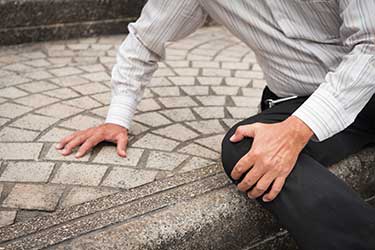
The short answer is that slip and fall accidents can take varying times to resolve, and the timetable for any given slip and fall case in California or elsewhere depends upon the facts of the case.
At the same time, however, slip and fall claims tend to have similar elements, and it can help for slip and fall injury victims to understand the process of filing a premises liability claim in order to have a better understanding of the length of time for any given slip and fall case or settlement.
Slip and Fall Cases Can Be a Lengthy Process
It is a question that slip and fall accident lawyers get all the time: How long is my case going to take? There are two honest answers to this question. Unfortunately, the answers aren’t satisfying:
- There is a lot of uncertainty regarding length. The time it takes to settle California slip and fall accident claims vary; and
- Most slip and fall accident cases take quite a long time to settle. Many take more than a year in litigation.
There is no way around it. The personal injury claims process, particularly for slip and fall accident cases, is not fast. Further, insurance companies fight these types of claims. This can lead to a long and drawn out settlement process. Most slip and fall cases are not settled in pre-litigation. Instead, someone must file a complaint in court to get the ball rolling.
Example of a Slip and Fall Injury Case in California
How long do slip and fall settlements take? In order to provide you with more information about this question, we want to give you a hypothetical example of a slip and fall case that we will use to tell you more about how the premises liability settlement process works.
Here is an example of a slip and fall case:
Joe was grocery shopping at a local supermarket. He was wearing shoes with a leather sole, which tend to be somewhat slick on flat surfaces, but he came directly from work. Joe usually wears his leather-soled shoes when he makes any stops on his way home from work, and he has never had any problems in the past.
Joe knows he needs only a handful of items on a grocery list, including a new bottle of olive oil. He heads down the aisle with oils and other cooking supplies, carrying a shopping basket that is relatively heavy since it is filled with other grocery items. The floors in the supermarket are an off-white color, so Joe does not notice that a bottle of olive oil spilled on the floor.
Clearly, someone cleaned up part of the spill previously—there are no signs of a broken bottle, and only the olive oil remains on the floor. Joe is rushing down the aisle to grab the oil he needs because he realizes he is late to pick up his child from daycare. While rushing down the aisle, Joe slips and falls on the oil. As a result of the slip and fall, Joe breaks his wrist and suffers a concussion.
Because of the concussion, he needs to take several days off from work, and he also needs extensive surgery and follow-up medical treatments to repair the multiple breaks in his wrist. How is Joe’s slip and fall case likely to proceed?
Understanding the Slip and Fall Accident Claims Process
Demand Letter and Insurance Negotiations
Typically the first step in a slip and fall settlement is to send a demand letter to the property owner to seek compensation for losses through insurance. The supermarket in the example above likely has insurance, and Joe’s premises liability lawyer could attempt to negotiate with the insurance company for a fair slip and fall settlement.
In order to convince the insurance company to offer a fair settlement, the demand letter usually needs to make clear that Joe would win a slip and fall lawsuit because the facts of the case meet the essential factual elements of a premises liability claim:
- Supermarket owner or manager (the defendant) controlled the property where Joe slipped and fell;
- Supermarket owner or manager was negligent in failing to properly clean up the oil spill in the aisle;
- Joe (the plaintiff) suffered harm as a result of the defendant’s negligence; and
- Supermarket’s negligence was a substantial factor in causing Joe’s injury.
In some cases, the defendant’s insurance company will negotiate a fair settlement, but in other cases, the plaintiff will need to file a premises liability lawsuit. When an insurance company makes a fair settlement offer, a slip and fall settlement can occur very quickly—within weeks to a couple of short months after the accident.
However, when a plaintiff needs to go to court, the timetable for a settlement offer becomes much longer.
Filing a Premises Liability Claim in California
A plaintiff has two years from the date of the slip and fall injury to file a premises liability lawsuit in California. This is known as the statute of limitations. As long as two years have not passed, Joe’s lawyer can prepare a complaint.
The complaint will provide key factual information about the case, such as who is being sued, where and how Joe slipped and fell, and what kinds of damages Joe expects the supermarket to pay for his injuries.
Damages in slip and fall cases typically include compensatory damages, which compensate a victim for losses. These can include economic damages (like lost wages and medical bills) as well as non-economic damages (like pain and suffering).
Once Joe files a complaint, the defendant will be able to file a response, which is known as an answer. The answer typically involves the defendant admitting to or denying the statements in Joe’s complaint. In the answer, the defendant can also bring up any affirmative defenses, such as a comparative fault.
Under California law, a plaintiff’s damages can be reduced if he bears some responsibility for the accident. In the hypothetical, the defendant might argue that Joe is partially to blame because he worse shoes with slippery soles and that he would not have slipped otherwise.
At any point, after Joe has filed a complaint, the defendant can offer a settlement amount. If it is acceptable, Joe can take the settlement offer and end the case. If not, Joe’s lawyer can negotiate a better settlement, or the case can move forward. The longer a case remains in court, the lengthier the timetable before Joe receives compensation.
Discovery and Premises Liability Trial Motions
If a case moves forward without a settlement, it will go through a phase known as discovery (where both parties gather evidence), and then to trial motions. It can take quite awhile for the discovery process to conclude, as well as to set court dates and to appear before a judge.
At any point still, the parties can settle and the case can close.
Mandatory Settlement Conference and Going to Trial
Before trial, the parties usually will be required to attend a mandatory settlement conference (California Rule 3.1380). The settlement conference is designed to get the parties to reach an agreement so that there is no longer a need to go to trial. Sometimes the parties will settle at this point if there is a reasonable settlement offer.
What are reasonable slip and fall out of court settlement amounts? These vary greatly depending on the situation, but typically a fair settlement covers the plaintiff’s losses.
If the parties cannot settle, the case will go to trial. This can extend the timetable immensely. Slip and fall cases that go to trial can take many months—and often more than a year—before a plaintiff like Joe is able to obtain compensation for his losses. While settlements can help plaintiffs to get compensation faster, sometimes it is necessary to take a slip and fall case to trial and ultimately to a judge or jury verdict if the defendant will not offer a reasonable settlement amount.
Contact a California Premises Liability Lawyer
Were you injured in a slip and fall accident? An experienced California slip and fall lawyer can help you to get the settlement you deserve. Contact The Beliz Law Firm for more information about getting started on your claim.
